Civil Engineering (CE) Exam > Civil Engineering (CE) Notes > RCC & Prestressed Concrete > Limit State Method
Limit State Method | RCC & Prestressed Concrete - Civil Engineering (CE) PDF Download
IS 456 Standards for Beams and Slabs and Columns
Effective span
- Simply supported beams and slabs (leff)
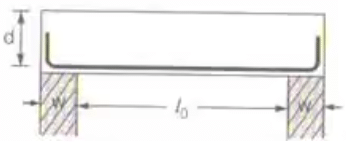 Here, l0 = clear span
Here, l0 = clear span
w = width of the support
d = depth of beam or slab - For continuous beam
(i) If the width of support < 1/12 of clear span
(ii) If the width of support > 1/12 of clear span
(a) When one end fixed other end continuous or both end continuous. (b) When one end continuous and the other end simply supported
(b) When one end continuous and the other end simply supported 
- Cantilever
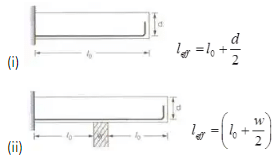
- Frames
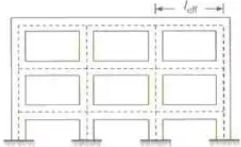 leff = Centre to centre distance
leff = Centre to centre distance
Control of deflection
- This is one of the most important checks to limit the state of serviceability.
(i) The final deflection due to all loads including the effect of temperature, creep and shrinkage and measured from the as-cast level of the support of floors, roofs and other horizontal members should not normally exceed span/250.
(ii) The deflection including the effect of temperature, creeps and shrinkage occurring after the erection of partition and application of finishes should not normally exceed span/350 or 20 mm whichever is less. - The vertical deflection limit may generally be satisfied if
(i) Basic span to effective depth ratio for span upto 10m is
Types of Beams: span/effective depth
For cantilever → 7
For simply supported → 20
For continuous → 26
(ii) For span > 10 m effective depth = (span)2/10 x 2
Where 'A' is span to effective depth ratio for span upto 10m.
(iii) Depending upon the tension reinforcement the value 'A' can be modified by multiplying a factor called modification factor (MF1)
effective depth = span/A x MF1
where,
(iv) Depending upon the area of compression reinforcement, value (A) can be further modified using a modification factor (MF2)
effective depth = span / A x MF1 x MF2
(v) For flanged beam: A reduction factor is used
(vi) Deflection check for two way slab:
Slenderness limit
- For simply supported or continuous beams
 where, l0 = Clearspan
where, l0 = Clearspan
b = Width of the section
and, d = Effective depth - For cantilever beam

(i) Minimum tension reinforcement =
(ii) Maximum tension reinforcement = 0.04 bD
(iii) Maximum compression reinforcement = 0.04 bD where, D = overall depth of the section
(iv) Where, D > 750 mm, side face reinforcement is provided and it is equal to 0.1% of gross cross-section area (b × D). It is provided equally on both faces.
(v) Maximum spacing of side face reinforcement is 300 mm.
(vi) Maximum size of reinforcement for slab/beam is 1/8 of the total thickness of the member.
(vii) Nominal cover for different membersBeams → 25 mm
Slab → 20 to 30 mm
Column → 40 mm
Foundations → 50 mm
(viii) Moment and shear coefficient for beams/slabs
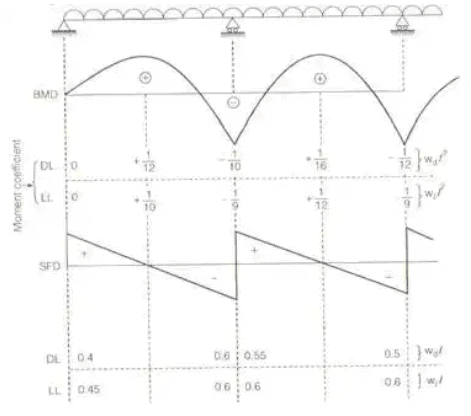
One way slab
(i) ly / lx > 2 where ly = length of a longer span
lx = length of shorter span
(ii) Slab is supported only on two edges.
Design of One way slab
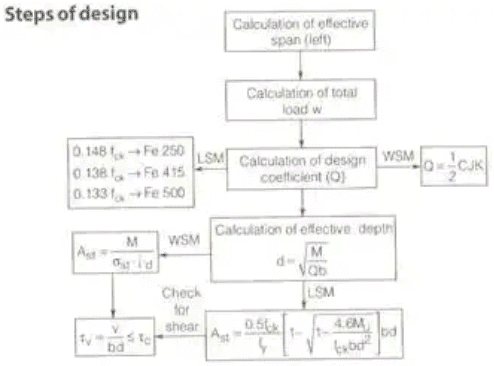
Two-way slab
(i) ly / lx ≤ 2
(ii) Slab is supported on all edges.
Design of two way slab
Grasoff Ranking method
It is used for corners not held down position.
It is a purely simply supported case.
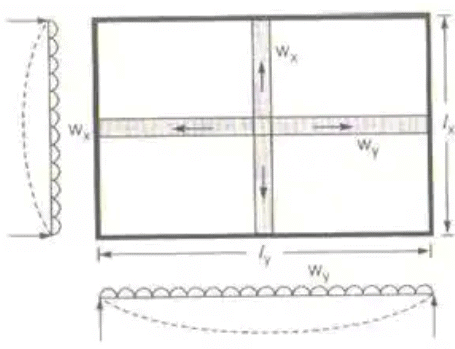
(i) 
(ii) Moment in x-direction 
Moment in y-direction 
(iii) Shear force
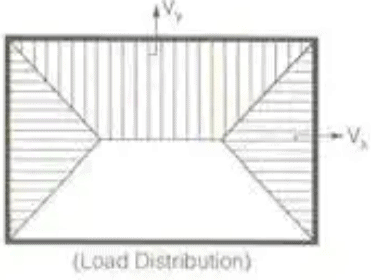
At shorter edge (VX)
At longer edge (Vy)
Design of slab with corner held down the position
- Pigeauds method:

where the values of rx and ry are read from the table - I.S. code method:
Mx = αxwl2y, My = αywlx2
The values of αx and αy read from the table (page 91, IS : 456-2000)
The document Limit State Method | RCC & Prestressed Concrete - Civil Engineering (CE) is a part of the Civil Engineering (CE) Course RCC & Prestressed Concrete.
All you need of Civil Engineering (CE) at this link: Civil Engineering (CE)
|
13 videos|43 docs|34 tests
|
FAQs on Limit State Method - RCC & Prestressed Concrete - Civil Engineering (CE)
| 1. What is the Limit State Method in civil engineering? |  |
Ans. The Limit State Method is a design philosophy used in civil engineering to ensure structural safety. It involves analyzing and designing structures based on predetermined limit states, such as strength, serviceability, and stability, to ensure that the structure performs adequately under various load and environmental conditions.
| 2. How does the Limit State Method differ from the Working Stress Method? |  |
Ans. The Limit State Method and the Working Stress Method are two different approaches to structural design. The Working Stress Method focuses on the stresses developed in the structure and ensures that they remain within permissible limits. In contrast, the Limit State Method considers the behavior of the structure as a whole, analyzing its ability to meet specific limit states, such as collapse, excessive deformation, or loss of functionality.
| 3. What are the different limit states considered in the Limit State Method? |  |
Ans. The Limit State Method considers various limit states, including ultimate limit state (ULS) and serviceability limit state (SLS). The ultimate limit state ensures that the structure can resist the maximum loads without failure, while the serviceability limit state ensures that the structure remains functional and comfortable for its intended use without excessive deflection, vibration, or cracking.
| 4. How are loads and load combinations considered in the Limit State Method? |  |
Ans. In the Limit State Method, loads are classified into different types, such as dead loads, live loads, wind loads, and earthquake loads. These loads are then combined based on appropriate load factors and load combinations defined by design codes or standards. The load combinations are chosen to represent different scenarios that the structure may encounter during its lifespan, ensuring a comprehensive analysis of its behavior under various conditions.
| 5. What is the role of safety factors in the Limit State Method? |  |
Ans. Safety factors play a crucial role in the Limit State Method as they account for uncertainties in material properties, construction processes, and load estimation. These factors are applied to the characteristic loads and material strengths to ensure an adequate level of safety. Safety factors are determined based on the desired level of reliability and are specified in design codes or standards, providing a margin of safety for the structure against potential failures.
Related Searches
















